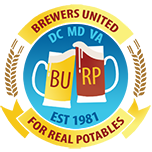Spicing Up Your Beer |
- Home
- Enlightenment
- Brewing Tips
- Spicing Up your Beer
Brewers United for Real Potables
Spicing Up Your Beer
By Steve Marler
t’s November, it is getting colder, and Thanksgiving is right around the corner. Many brewers have or are starting to think about brewing beers for the holidays, and the December BURP meeting. Some of you may be considering brewing a beer with herbs and spices. Here are some tips on brewing herb and spice beers.
The Recipe
When designing your recipe, think about how the herb/spices are going to interact with the flavor of the beer. One suggestion is to look toward your favorite foods to find complimentary flavor combinations and try to imagine how these flavors will either blend or contrast with the base beer [Zainasheff and Palmer]. Your base beer should generally have a lower IBU level and not have late hop editions. This will allow the spice and herb flavors come through. If you want create the impression of a holiday dessert, bigger and sweeter base beers would be appropriate. For a beer that provides a spicy food impression, consider something dryer and less sweet. If the herbs/spices you are planning to use have delicate flavors, a lighter base beer such as a blonde ale and Kolsch would work well. For bolder and more flavorful base beers, increasing the amount of herbs/spices will be necessary, especially if they have delicate flavors. According to Gordon Strong, understanding the interactions between recipe variables you tweak and how they finally balance is your goal. He suggests avoiding clashing flavors. By understanding common flavor clashes and how flavors balance and complement each other you can avoid most of these problems. Strong notes the following clashes:
Dark malts and citrusy/piney hops
Yeast, spice, or fruit and bitterness/late hops
Fruit and spice (make sure the combination works)
Sour and bitter
Harsh and harsher (spices and coffee)
Spicy/hot and bitterness/alcohol (the spicy/hot
spcies can amplify bitterness and alcohol impression)
You can easily overdose on spices. I remember BURP member Polly Goldman saying that she believes in the rule of three: no more than three individual herbs/spices. Five spices might be great for the chili at the BUPR chili cook-off, but it is hard to balance all those flavors in a beer. It is better to go with fewer flavors and aromas. Remember, you are making beer. It should taste like beer and have a beer character. The spices/herbs should be noticeable but in harmony with the rest of the beer and it should not overwhelm the beer character [Zainasheff and Palmer]. Strive for a mysterious blending of flavors. These beers are best when the individual flavors don’t jump out at you [Mosher].
The Process
There are a couple of ways that you can add herbs and spices to your beer. The first that comes to many brewers minds is to add them at the end of the boil. If this is your preferred method, then add them during the last few minutes to retain as much of the volatile aromatics as possible. You can also add herbs/spices by dry hopping, and making teas and potions. Dry hopping with herbs/spices is similar to dry hopping. Add them to the beer after primary fermentation has subsided. Because of their size and possibility of being transported to the keg or bottling bucket when racking, consider putting the herb/spices in a hop bag. Always keep your eye on sanitation. There are two benefits to making teas and potions: the risk of contamination is lower; and you can control the exact dosage of the herb or spice being added. To make a tea, boil a cup or two of water, turn off the heat, and add your spices. There are different thoughts on what to do next. Let the tea sit until it has adequately cooled, then add the entire volume, including the spices, to the beer [Zainasheff and Palmer]. Or run the tea through a coffee filter [Mosher]. Potions are made by soaking the herbs/spices in vodka for a week or two. The alcohol in the vodka will leach out the essential flavors. Once you determine that your potion has enough flavors, then filter out the herbs/spices. Do not add your dry hop herb/spices, tea, or potion during fermentation. The escaping CO2 will scrub out the volatile oils. If you filter as Mosher suggests, you can control the mix and strength of the spicing. To do this you will first need to conduct a small-scale experiment by adding a measured amount of the tea or potion to a small sample of beer. This can be done by using a pipette or syringe. Test how much of the mixture needs to be added for the best flavor, and then scale it up to the rest of the batch. Here is an example from Mosher on how to scale up your test:
1 ounce beer sample to 5 Gallons
1oz x 128(oz per gallon) x 5 (gallons in batch) = 640 ounces/batch
If the test determined that 0.2 ml was the correct amount for a 1 ounce sample, then:
.2 ml x 640 = 128 ml of potion must be added to match the small scale test.
We look forward to drinking your spiced Holiday beer at the BURP Holiday Party.
References
Gordon Strong, Brewing Better Beer, (Boulder, CO:Brewers Publications, 2011)
Jamil Zainasheff and John J. Palmer, Brewing Classic Styles, (Boulder, CO: Brewers Publications, 2007)
Randy Mosher, Radical Brewing, (Boulder, CO: Brewers Publications, 2004)
